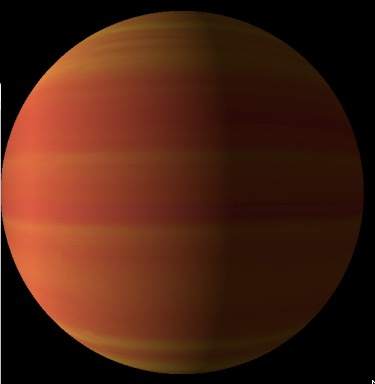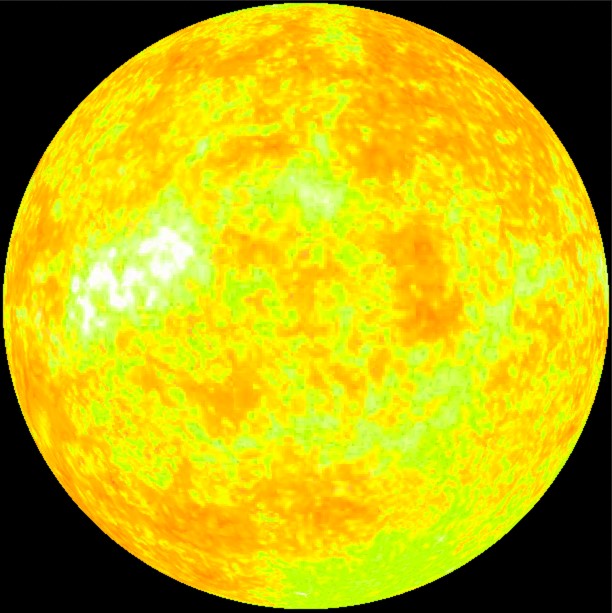Pi Mensae c
<Image of Pi Mensae c Exokyoto system automated selection, © 2018 ExoplanetKyoto- Ryusuke Kuroki, Yosuke A. Yamashiki and Natsuki Hosono>
Pi Mensae c orbits around a somewhat large and bright G-type star Pi Mensae, and is categorized as a Super Earth, with a radius of about two times that of Earth. This planet was first reported in arXiv in September 2018, the first exoplanet discovered by TESS, the Transiting Exoplanet Survey Satellite. Furthermore, another orbiting planet, Pi Mensae b was discovered in 2001 and was found to have a mass 10 times that of Jupiter.
<From the right: (1) our sun and Pi Mensae (HD 39091) (2) Jupiter (3) Earth and Pi Mensae comparison>
Pi Mensae c is thought to have a small mass relative to its size and be less dense than the Earth. Therefore, it is presumed to be a planet with a lot of water, or have a thick atmosphere. Also, since the distance from the host star is only about 1/50 of the distance from the sun to Mercury, water is thought to evaporate at very high temperatures on its surface.
<pi Mensae c (HD 39091 c) orbit, and the runaway greenhouse effect line (in green)>
Pi Mensae c is about 60 light-years away from the earth and the apparent magnitude is 5.67, so if you are in a very dark environment you can see it with the naked eye. If you are ever traveling in the southern hemisphere and see this star, you can tell everyone that “a Super Earth revolves around that star!”
For more information on Pi Mensae c, please see the ExoKyoto database:
http://www.exoplanetkyoto.org/exohtml/pi_Men_cJP.html
<Pi Mensae b> Super Jupiter with an eliptical orbit.
<Imaginary image of pi Mensae b Exokyoto system automated selection, – © 2018 ExoplanetKyoto – Ryusuke Kuroki, Yosuke A. Yamashiki and Natsuki Hosono>
Two exoplanets have been discovered orbiting the main sequence star Pi Mensae (HD 39091), which is said to have a radius of 2.1 times the sun. The first, Pi Mensae b (HD39091b) was discovered in 2001. This planet is thought to have a mass of 10.02 times that of Jupiter, and it has an elliptical orbit of around 1-5 astronomical units from its host star. This orbit goes from just inside the Venus-equivalent orbit, to the outside of the habitable zone and takes about 2093 days. The radius of Pi Mensa b has yet to be accurately observed.
For more information on Pi Mensae b, please see the ExoKyoto database:
http://www.exoplanetkyoto.org/exohtml/pi_Men_bJP.html
<Elliptical orbit of Pi Mensae b (HD 39091 b)(purple line) and the habitable zone according to Kopparapu et al. 2013>
Mensa comes from the Latin meaning “table.” In Japanese, the Mensa constellation is “table-san” which translates to “table mountain.” Table Mountain (Mons Mensae in Latin), al plateau-like mountain overlooking the city in Cape Town, South Africa, which is a characteristic topography around the Cape of Good Hope. It is one of the 14 (12) constellations in the southern sky discovered by the French astronomer Abbé Nicolas-Louis de Lacaille.
A photo of Table Mountain for reference.
<Mons Mensae – Table Mountain, photo taken by Yosuke A. Yamashiki in 2000, © 2018 ExoplanetKyoto>>
















